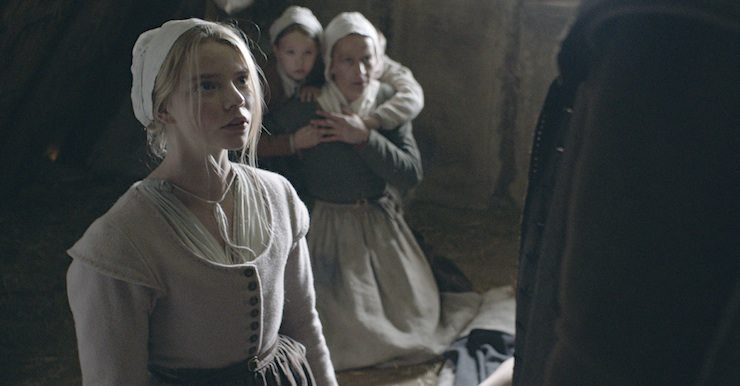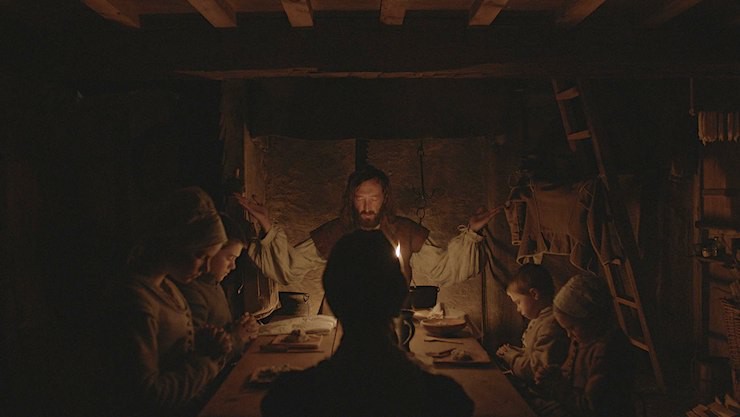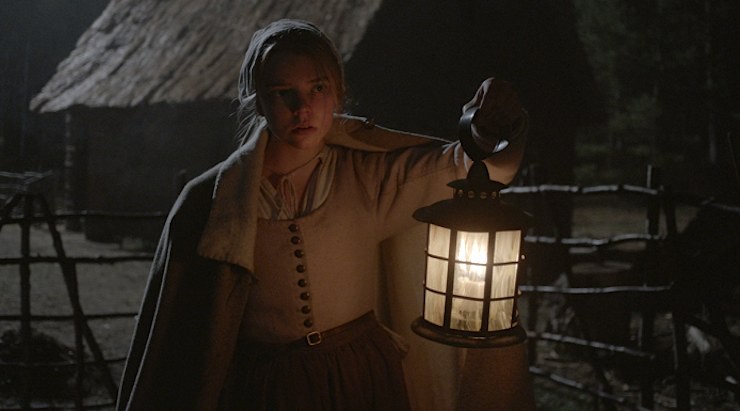If you use the words “horror” and “New England” together in a sentence, most aficionados of the genre will think first of H.P. Lovecraft and the Salem witch trials. You should now include The Witch in that list, a tightly crafted and deeply unsettling film that was a hit at Sundance and Fantastic Fest, and which has a very strong claim to being one of the best horror films of the year.
The Witch is set in New England in the early seventeenth century, when the Puritan settlers were still new to the area and culturally not so far removed from the England that they left in search of religious freedom. As the film opens, a clash of religious views between a man called William and the elders of a small town leads to the banishment of William, his wife Katherine, and their five children. They try to make a homestead in the wilderness, in a small house on the edge of a forest: “We will consume this wilderness,” William says, “it will not consume us.” This would be a challenge under any circumstances, and it’s only made worse by dark currents of tension beneath the seeming family harmony.
William has inculcated his family with a harsh religious doctrine, such that even the children believe they are inherently wicked and sinful. The eldest child, a teenage girl named Thomasin, is growing into a beautiful young woman, which strains her relationship with her mother and draws the attention of her younger brother Caleb; he is on the verge of adolescence, and there are no other girls in the vicinity on whom to cast his eyes. The toddler twins Jonah and Mercy have developed a peculiar attachment to the family’s billy goat, a majestic beast named Black Phillip, which sports a massive pair of curved horns and a shaggy black coat.
One afternoon, the youngest child, baby Samuel, literally disappears from under Thomasin’s nose during a game of peek-a-boo; soon after, the crops begin to fail, and the family begins to fracture as their faith is tested. Katherine becomes increasingly convinced that the family is cursed; William spends more and more time violently chopping wood in the yard; Thomasin emerges as a voice of reason and the closest thing to a cool head, but she quickly becomes the focus of her entire family’s fears, and will be made to suffer for it.
Lesser filmmakers might have tried to invent intrigue by repeatedly trying to fake out the audience as to whether the terrible things that happen in the film are supernatural or psychological in nature, and then answering the question with an unearned “twist” at the end. Director and writer Robert Eggers—making an incredibly self-assured first feature film—has no truck with that kind of clichéd storytelling; it isn’t long before we know where the heart of the trouble lies, which rather than deflating the story, only raises the stakes even higher. (And no, I’m not going to explain it here and spoil it for you. You definitely want to see this for yourself.)
If you’re a fan of old-fashioned British horror films, you may find that The Witch is occasionally reminiscent of classics like Blood on Satan’s Claw. Eggers, who I spoke to briefly after the film’s first Fantastic Fest screening, actually didn’t develop the story from the “British folk horror” angle; in fact, he only learned about those films after The Witch was in production. Instead, he’s used primary sources from New England witchcraft lore, witch trials, and other documents of the era, and he skillfully appropriates the Puritan New England language. (The film is subtitled “A New England Folk Tale”.) Of course, the characters are themselves not so far removed from their old lives in England—Katherine still thinks of it as “home”—and the time period is roughly that of the transitional, pre-Enlightenment period of the mid-1600s that you encounter in films like Witchfinder General and, more recently, A Field in England.
But any similarities of plot and style are coincidental and largely superficial. As fond as I am of the folk horror films of the 1960s and 1970s, I have to note that The Witch is quite frankly superior in nearly every way. The direction, cinematography, and production design are impeccable, and the small cast is outstanding. You may recognize the actors playing William and Katherine from Game of Thrones—Katherine is played by Kate Dickie, last seen making a dramatic exit from the Eyrie. They are excellent, but it’s Anya Taylor-Joy as Thomasin who holds the film in her hand with her fearless performance. Thomasin endures much and must make harrowing decisions, and Taylor-Joy makes her a compelling and sympathetic character for every step of the way.
The Witch is also missing the often reactionary undertones of many folk horror films—refer to the explicitly Christian ending of The Devil Rides Out or the anti-youth, anti-hippie not-really-sub-text of Blood on Satan’s Claw for a couple of examples. Thomasin’s nascent womanhood is partly a catalyst for the events that ensue, but not through any fault of her own; the fault lies in the reactions of others—her mother’s jealousy, her brother’s confused and wandering eye. Without giving too much away, I’ll merely note that it’s possible to see Thomasin’s story as a movement toward personal agency. Exactly what that means and how it transpires, I leave to the reader to discover when the movie opens in your local theatre in February of next year.
Karin Kross lives and writes in Austin, TX. She may be found elsewhere on Tumblr and Twitter.












